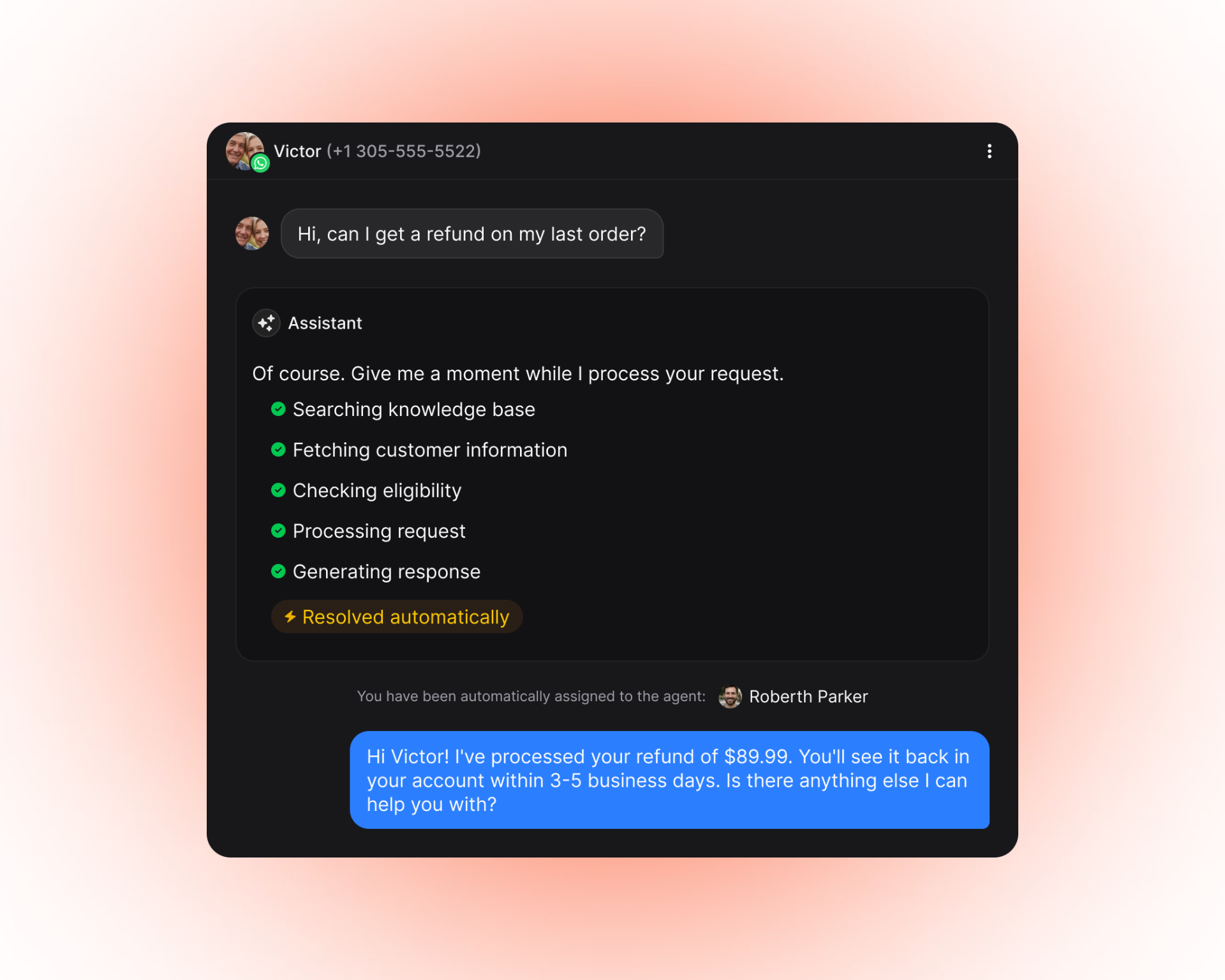TL;DR
Most “AI for customer support” tools aren’t truly collaborative, they’re either rigid bots or complex platforms that isolate automation from human teams. Invent reimagines support as “multiplayer,” where AI and people share context and workspace, orchestrating multiple models, continuous learning, and seamless handoffs.
The result: less friction, more trust, and human–AI collaboration that drives real customer outcomes.
Introduction
For the last few years, “AI for customer support” has sounded the same everywhere. Every platform promises smarter chatbots, faster responses, and fewer tickets. But when you look closer, most tools fall into one of two camps:
- Static chatbots bolted onto existing systems – a widget that answers FAQs, maybe creates a ticket, but lives in its own little world.
- Heavy, inflexible platforms – powerful, but complex. You can do a lot… as long as you’re ready to redesign your workflows, wire up dozens of tools, and babysit the bot.
We built Invent because both of these approaches miss the core truth: support is multiplayer.
It’s not just “a bot talking to a customer.” It’s a coordinated effort between AI, human agents, managers, operations, systems, and data. If your AI doesn’t live inside that reality, it will always feel like a sidecar—something you constantly fix, monitor, and explain.
Invent exists to change that.
Instead of yet another bot, we’re building a multiplayer AI support workspace: one place where AI and humans share context, collaborate in real time, and continuously improve together.
What’s broken with current AI support tools
On paper, AI support tools promise a simple story: automate the repetitive stuff, free your agents for high-value work, improve CSAT.
In reality, teams run into the same problems over and over.
1. Chatbots that respond, but don’t really resolve
Most tools are great at giving an answer, not necessarily the right one, or the full resolution.
A typical flow:
- Bot answers with something from your help center.
- Customer isn’t quite satisfied, asks a follow-up.
- Bot repeats itself or gets lost.
- Customer types: “I want to speak to a human.”
- Conversation restarts with a human, who now has to ask all the same questions again.
You’ve added friction without meaningfully reducing work. Customers get frustrated; agents don’t trust the bot; managers start turning AI off “for safety.”
2. Heavy platforms that still leave you stitching things together
On the opposite end, you have big platforms that promise full control: flows, rules, conditions, granular routing.
They’re powerful, but they often assume:
- You’ll redesign your process around the tool.
- You have the time to maintain flows, prompts, and integrations.
- Your team can invest weeks or months to get value.
You end up with a sophisticated system that still requires manual wiring: one tool for chat, another for knowledge, another for analytics, another for routing. AI becomes yet another layer to manage.
3. AI that’s blind to real context
Most generative AI tools treat each message as an isolated text prompt:
- Little to no awareness of past conversations.
- Weak memory of customer preferences or history.
- Limited understanding of internal systems (subscriptions, orders, SLAs).
They’re “smart” in how they generate language, but not in how they use context. In support, context is everything.
Support is and should be multiplayer by nature
Support is a team sport.
On any given day, a single customer issue can touch:
- A chatbot or AI assistant
- A frontline support agent
- A specialist or team lead
- An ops person updating documentation
- A product manager watching patterns in conversations
- CRM, billing, internal dashboards, incident trackers
And importantly, the roles aren’t static:
- AI might start the conversation, but hand off to a human.
- A human might resolve something today that AI should handle tomorrow.
- A manager might promote a great human reply into a reusable pattern the assistant can learn from.
This is what we mean by multiplayer support: multiple actors, some human, some AI when needed, sharing the same customer context, the same workspace, and the same goal: resolve the issue as quickly, accurately, and empathetically as possible, not just respond.
- If your AI doesn’t live inside that shared workspace, it’ll always be an appendix.
- If your humans can’t see, steer, and improve what AI is doing, trust will never build.
So we designed Invent around one simple idea:
AI and humans should work in the same place, with the same information, as part of the same team.

Contact details for Maya in the support workspace, indicating she’s chatting via the web widget in Chrome on macOS and prefers English (US) and Spanish.
What Invent is: A collaborative AI support layer
Invent is a collaborative support layer that sits across your existing tools and orchestrates multiple AI models, your documentation, your customer data, and your agents into one unified experience.
At a high level, Invent does four things:
- Orchestrates multiple models and tools behind a single assistant.
- Keeps rich, per-customer memory.
- Lives in the same workspace as your agents.
- Continuously learns from real interactions.

Customer profile for Maya with Zydeer as the AI assistant and Jorge Trujillo as the currently assigned live agent.
A day in the life with Invent
Imagine a customer named Maya opens your chat widget and types:
“Hey, I want to talk to a human.”
1. AI starts, but doesn’t insist on staying in control
Invent’s assistant greets Alberto based on his history:
- Knows she’s used the widget before.
- Knows his language preferences (say, English and Spanish).
- Has memory of previous orders or preferences.
The assistant may try to help first:
“Hi Alberto! I can help you with most things right away. Are you reaching out about your recent order, billing, or something else?”
If Alberto insists:
“I want to talk to a human.”
Invent doesn’t argue. It respects the intent and routes the conversation to a human agent.
2. Handoff with full context
When the human agent (say, Jorge) takes over, they don’t see an empty chat. They see:
- The full conversation so far.
- Maya's preferences (e.g., “always orders pizza with cheese,” “likes cars,”etc).
- Her language, browser, and device.
- Any relevant internal context (recent tickets, plan, important tags).
This is all visible in a right-hand panel: memories, metadata, and assistant/agent assignment, so that Jorge starts already knowing the customer, instead of asking basic questions again.

Customer memory view displaying saved preferences, including a weekly Monday order habit, a preference for cheese pizza, and an interest in cars.
3. Human and AI continue collaborating
Even while Jorge is talking directly to Maya, AI hasn’t left the room:
- It can suggest replies or next actions to Jorge.
- It can pull relevant docs or past tickets into the context.
- It can summarize long threads for a supervisor.
- If Maya comes back in a week with a related issue, the assistant picks up with that history in mind.
This is multiplayer support in practice:
AI and humans sharing a workspace, rather than fighting for control.

AI assistant automates a refund request, from checking eligibility to processing the refund, before handing off to a human agent who confirms the $89.99 reimbursement to the customer.
Why orchestration matters more than any single model
Models are interchangeable; orchestration is the product.
Different support tasks benefit from different capabilities:
- Classification & routing → smaller, fast models.
- Knowledge retrieval → specialized search + embeddings.
- Long, nuanced conversations → top-tier language models.
Invent orchestrates all of this behind one simple interface:
- A single assistant that feels unified to your team and your customers,
- While under the hood, multiple models and tools are doing exactly the jobs they’re best at. We call it Auto.
This has a few big advantages:
- Resilience: if one model degrades, we can route around it.
- Cost control: not every task needs an expensive model.
- Customization: different customers (or workflows) can prefer different model stacks.
- And most importantly: your team never has to think about this.
They see an assistant that works; we handle the orchestration.
Less time designing trees, more time watching metrics move
Most teams we talk dream of very specific outcomes:
- Higher self-service deflection.
- Lower average handle time.
- Better first-contact resolution.
- Higher CSAT.
Invent is built to focus you on those outcomes instead of on configuration.
Because the assistant:
- Reads and stays synced with your docs.
- Learns from past conversations.
- Shares a workspace with your agents.
- Taps into your systems (CRM, billing, internal tools).
And with this, you spend far less time:
- Designing decision trees.
- Micro-tuning prompts.
- Micromanaging bot behavior.
Instead, you spend more time:
- Deciding where AI should confidently automate.
- Improving Instructions and enriching AI Knowledge.
- Watching deflection and handle time trends in your reporting.
We want you to feel like AI is an extra teammate, not another system to maintain.
Our Vision: Human-led, AI-amplified support
In a world where every vendor says “we use AI for support,” we think the framing is wrong.
The future isn’t AI instead of humans.
It’s humans and AI sharing the queue, each doing what they do best.
Here’s the world we’re building toward with Invent:
- AI resolves the repetitive 60–80% of issues: password resets, plan questions, order status, policy clarifications, fast, accurate, and in any channel as WhatsApp, Email, Instagram and others.
- Humans handle the complex, emotional, or high-stakes 20–40%: escalations, nuanced edge cases, relationship-sensitive situations.
- Every time a human solves something new or tricky, the system learns, so that next time, AI can help, or at least set the human up better.
- Managers and ops people can see where AI is reliable, where it needs help, and where documentation or processes are missing.
That’s what we mean when we say:
We’re not selling you a bot. We’re giving you a scalable ecosystem that plugs into what you already have, learns over time, and quietly turns painful support work into human–AI–human collaboration.
Support will always be about people: your customers and your team.
Our job is to make sure AI amplifies both sides.
What’s next
If this resonates with you, you’re probably already feeling the limits of today’s tools:
- You’ve tested a few chatbots that looked good in demos but broke down with real traffic.
- You’ve tried to wire AI into your helpdesk and ended up maintaining more glue than automation.
- Your agents are skeptical of AI because it often makes their work harder, not easier.
We’re building Invent for teams exactly like yours.
- If you want to treat AI as another member of your support team, not a black box,
- If you care about real resolution, not just responses,
- If you believe support is inherently multiplayer,
then we’d love to talk, show you how Invent works in your environment, and hear where you want AI to help first.
The future of support is multiplayer.
Start creating your organization now on Invent.

